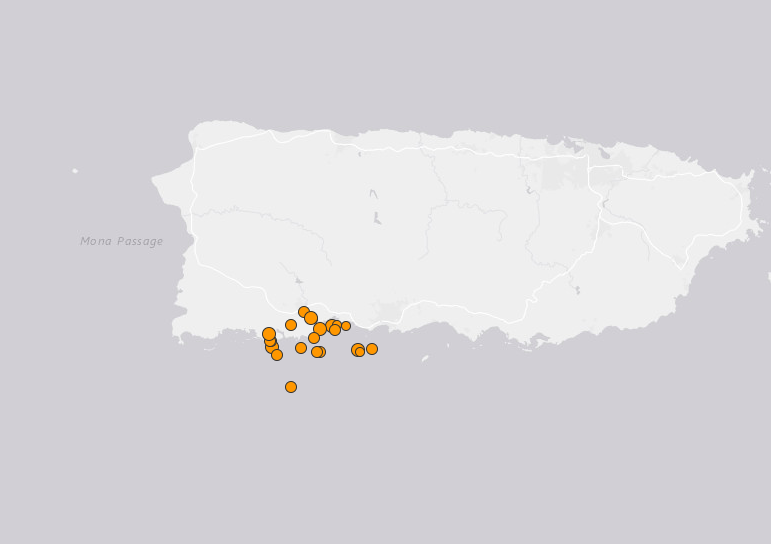
USGS
An image from the U.S. Geological Survey’s seismic tracker showing recent activity in southern Puerto Rico.There have been hundreds of small telluric movements in Puerto Rico since December 28, 2019, but the main earthquake of magnitude 6.4 on the Richter scale occurred on January 7, 2020. Much of the damage is reported in southern cities such as Guánica, Guayanilla, Lajas, Yauco and surrounding areas.
From New York, Rafael Ocasio Barreto, activist and community leader, has been following how his friends and family are living in this situation. “The survivors have no light, nor water.” According to the Associated Press, there are more than 1,000 people living in shelters, more than 250,000 people do not have water and another half million do not have electricity, “which also affected telecommunications.”
According to Karla Peña, Puerto Rico’s Mercy Corps director, about 25 percent of the population on the island is without drinking water. “People are out of their homes. Many people are sleeping in cars or tents.”
Power has been restored to about 33 percent of users on the island. However, the power plant in Guayanilla suffered severe damage that could take about a year to recover, José Ortiz, CEO of the Puerto Rico Electric Power Authority, told CBS today.
In response to this crisis, Gov. Wanda Vázquez and President Trump declared a state of emergency at different times. New York Governor Andrew Cuomo asked the New York Power Authority to deploy technical experts to work with the Puerto Rico Power Authority to restore power.
The destruction seen by some people brought back memories of Hurricane María that hit Puerto Rico in September 2017.
“What is greater than the visible damage to structures?” Rafael Ocasio Barreto asks over the phone. “The psychological damages. Those damages to people are difficult to calculate.” As an emergency measure, the American Red Cross chapter in Puerto Rico has “helped people to relieve anxiety with the support of volunteer psychologists, social workers, and professional counselors,” says Rosemarie Valdez, regional communications and marketing program manager for the American Red Cross in Puerto Rico.
According to Oscar Serrano, co-director of Centro de Periodismo Investigativo, “the major damage was concentrated in a specific area in the south of the island and most of the people affected are from there. Serrano clarifies that “many of the houses that have fallen down are the ones that suffered from the tremors since December 28.”
In Guánica, specifically, “there are 150 families affected so far,” says Danica Coto, a Puerto Rico-based AP correspondent. Also there, the American Red Cross provided “assistance to 13 affected families.” and “personal hygiene kits were distributed to 21 refugees” in the area. As Valdez clarifies, the American Red Cross in Puerto Rico “supports the refugees with hygiene items, such as diapers, and other basic services; however, it is the government [the governor’s office] that operates shelters.”
The most recent statement from Housing Department in the island, sent Jan. 7, reported that there were “746 refugees in 11 shelters located in San German, Lajas, Guánica, Ponce, Utuado, Guayanilla, Coamo, Maricao, Yauco, Peñuelas”. The statement also notified of the preventive and voluntary transfer of “the refugees located in the Coliseo Mariano Tito Rodríguez in Guánica to the shelter set up in Lajas in the Juan Lluch Court.”
According to Serrano “the number of families affected may be between 100 and 200 families.” Other sources, such as Coto, say that “there are more than a thousand refugees in total, so far.” Official figures report more than one death. It is still too early to know the true impact on the island and, as with Hurricane Maria, the number of people affected will take time to be known due to the multiple side effects.
So, if you want to monitor the seismic movements on the island, the Seismic Network Puerto Rico offers detailed information here.
So far there are no known official initiatives through which people can send aid to those affected on the island. However, some organizations such as the American Red Cross in Puerto Rico are receiving donations through their website.
In addition, organizations such as Friends of Puerto Rico and Hispanics in Philanthropy are looking for volunteers to distribute food. They also have a list of shelters where people can get tents. For more information go here.
At the local level, the Puerto Rico Community Foundation reactivated the Community Recovery Fund for those who wish to collaborate with non-profit organizations that are supporting the recovery efforts in the southwest of the island. You can donate here.
Noticel, digital newspaper, published a list of the most needed items along with other local initiatives.
If you know of organizations that are allocating resources to help communities affected by earthquakes in Puerto Rico or if you know other ways in which people can help, please write to us at daniel@citylimits.flywheelstaging.com









2 thoughts on “Puerto Rico’s Earthquakes: How You Can Help”
Quiero saber donde puedo llevar mis suministros para los damnificados del sur en el area de NY para que se los hagan llegar,Espero me puedan ayudar a encontrar esta info que busco.
Daniel Parra respuestas: Gracias por escribir. Si deseas donar en la ciudad de Nueva York la organización Diáspora por Puerto Rico ha listado estos lugares (https://www.facebook.com/diasporaxpr/photos/pcb.627692014646597/627691641313301/?type=3&theater) en Brooklyn, el Bronx, Queens y Manhattan que están recibiendo artículos esenciales. Si tienes más dudas no dudes en contactarnos.